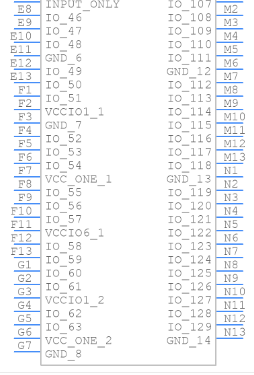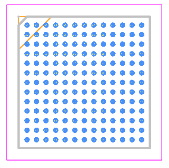Intel 10M02SCU169C8G FPGAs: Advantages, Applications and Datasheet
2025-03-06 14:32:23 1486
10M02SCU169C8G Description
The Intel 10M02SCU169C8G, part of Intel’s MAX 10 FPGA series, is a standout solution designed for applications that demand high performance and low power consumption in a compact form factor. It is designed to handle simple and complicated logic tasks, and its exceptional power economy and versatility make it a popular choice for consumer and industrial applications that demand reliable performance under power and space constraints.
10M02SCU169C8G Features
Logic Capacity and Configuration: The 10M02SCU169C8G comes with 2,000 logic elements (LEs), allowing for efficient handling of smaller to medium-sized logic functions. Despite its compact size, it provides ample configuration options, including the ability to implement state machines, memory functions, and combinational logic in diverse designs.
Low Power Consumption: One of the standout features of the 10M02SCU169C8G is its low power consumption. Intel's MAX 10 series is designed to offer energy-efficient solutions, and this model is no exception. It operates with a typical power consumption of under 1W, making it a highly cost-effective choice for battery-powered or low-power systems.
Flexible I/O Options: The 10M02SCU169C8G FPGA offers a wide variety of I/O options, including support for low-voltage differential signaling (LVDS), providing flexibility in interfacing with other high-speed components. Its I/O pins are configurable to support different voltages, ensuring compatibility with different system requirements.
Non-Volatile Memory (NVM): This FPGA comes with integrated non-volatile memory, meaning configuration data is retained even after power is turned off. This simplifies the system design by removing the need for an external configuration device, leading to reduced system complexity and costs.
Built-in Analog Features: The 10M02SCU169C8G integrates features like analog-to-digital (ADC) and digital-to-analog (DAC) conversion, offering unique value for systems that need analog signal processing within a digital logic platform. This integration reduces the need for external components, improving system reliability and reducing overall board space.
10M02SCU169C8G Applications
The Intel 10M02SCU169C8G is widely used in fields such as:
Automotive: With low power consumption and reliability, the 10M02SCU169C8G is ideal for automotive applications such as sensors, smart infotainment systems, and powertrain control.
Consumer Electronics: As an FPGA solution with versatile I/O support, it's a perfect fit for consumer electronics like smart home devices, wearables, and audio equipment.
Industrial Automation: It supports industrial applications requiring low power consumption and the ability to interface with multiple communication protocols, such as motor control and data acquisition systems.
Communication Systems: The FPGA can also be used in communication systems that require efficient signal processing and reliable data handling.
10M02SCU169C8G CAD Model
Symbol

Footprint

3D Model


10M02SCU169C8G Advantages
What sets the 10M02SCU169C8G apart from other FPGAs in the market is its combination of low power and flexibility. Many FPGAs in this category prioritize performance or power efficiency, but Intel’s MAX 10 series, including this model, provides a balanced approach. This makes it particularly valuable in applications where power consumption is a major concern without compromising flexibility or functionality.
Additionally, the 10M02SCU169C8G’s integration of non-volatile memory and analog features makes it a more complete solution than other FPGAs at a similar price point, offering a more cost-effective solution for complex designs that typically require separate analog and memory components.
10M02SCU169C8G Alternatives
Xilinx Spartan-6 FPGA: Known for its low cost and efficient logic operations, the Spartan-6 family is a direct competitor to Intel’s MAX 10 series, offering similar capabilities in a compact, low-power form.
Lattice Semiconductor iCE40 UltraPlus: This family provides low-power FPGAs for mobile and consumer applications, much like Intel’s MAX 10, with an emphasis on ease of use and flexibility.
Microsemi IGLOO2: IGLOO2 FPGAs are known for their ultra-low power consumption, making them ideal alternatives for battery-powered applications requiring high-performance logic functions.
Altera MAX 10 FPGA (other variants): Other variants within the MAX 10 series, such as the 10M08SCU169I7G, offer alternatives with varying features in terms of logic capacity, I/O options, and performance.
Xilinx Artix-7: Another low-power, high-performance FPGA alternative, particularly designed for applications that require high-speed operation and flexibility in terms of interfaces.
10M02SCU169C8G Manufacturer
Intel Corporation, a global leader in semiconductor manufacturing, is renowned for its innovation in the development of processors, memory, and AI solutions. Founded in 1968, Intel pioneered the microprocessor revolution, and it remains at the forefront of shaping modern computing and connectivity technologies. The company designs and manufactures integrated digital technologies, including the world’s most advanced microprocessors in personal computers, data centers, and cloud computing environments.
Intel's products also support industries ranging from artificial intelligence and autonomous vehicles to 5G and cloud infrastructure. Through its investments in R&D and partnerships with other technology companies, Intel continuously pushes the boundaries of performance, power efficiency, and connectivity. The company’s commitment to sustainability, responsible manufacturing, and advancing technological equity underscores its vision to create a positive impact on society.
As a trusted partner for millions of businesses and consumers worldwide, Intel continues to evolve, adapting to changing market demands and paving the way for future innovation. With a focus on high-performance computing and intelligent systems, Intel is shaping the next generation of technology.
10M02SCU169C8G FAQs
What are the long-term reliability features of the 10M02SCU169C8G in high-temperature environments?
While Intel provides operating temperature ranges, little information is publicly available on the long-term reliability of the 10M02SCU169C8G when exposed to high-temperature extremes. Testing in harsh conditions is advised to ensure the longevity of the component in real-world applications.
How does the integrated non-volatile memory handle frequent configuration updates during live operations?
The non-volatile memory in the 10M02SCU169C8G provides persistent storage, but there is limited information on how it behaves under frequent writes and configuration updates in real-time applications.
What unique power management features does the 10M02SCU169C8G offer for low-power systems?
The chip’s power management techniques are not fully disclosed, particularly its efficiency under extremely low-power conditions, such as during deep sleep or idle states in energy-sensitive designs.
Can the FPGA’s programmable logic and DSP capabilities be used simultaneously to enhance performance?
Details on how the programmable logic and DSP capabilities can be used in parallel or in conjunction to optimize performance in real-time applications (such as in communications or signal processing) remain sparse.
How does the 10M02SCU169C8G perform in multi-chip configurations when interconnects are critical for timing accuracy?
The 10M02SCU169C8G’s performance in multi-chip systems, especially with interconnect timing precision and synchronization, is not often discussed, leaving designers to determine how well it scales in more complex systems with multiple FPGAs.




